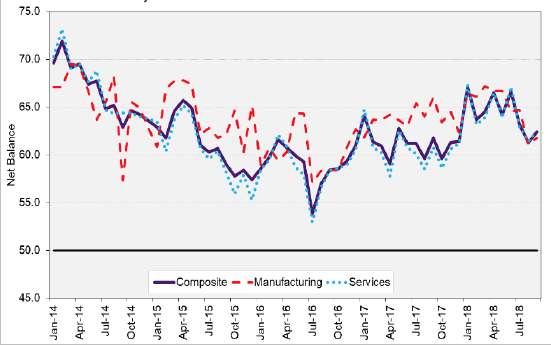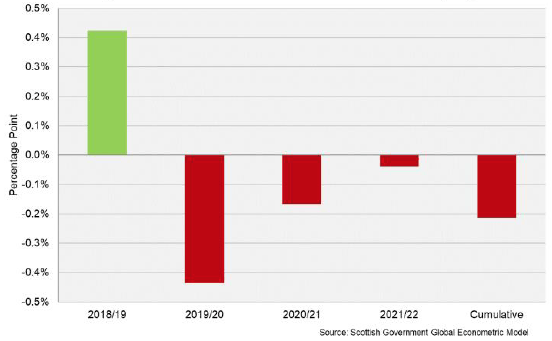State of the economy: October 2018
Report produced tri-annually by the Chief Economic Adviser to provide a picture of the Scottish economy in an international context.
This document is part of a collection
Business Sentiment
The latest Scottish business surveys[5] have signalled further growth in private sector business activity in Scotland in the third quarter of the year.
The RBS Purchasing Managers Index during the third quarter has signalled that private sector business activity growth in Scotland reached its highest levels since 2014. This was supported by further growth in demand for new business leading to firms continuing to expand staffing levels.
Royal Bank of Scotland PMI: Private Sector Confidence

The key driver of this growth was the services sector, which accounts for 75% of the economy, while the pace of growth in the manufacturing sector has eased back and contracted in September.
This chimes with the signals from the Scottish Engineering Quarterly Review which reported a slowing of growth in output, orders and exports from the engineering manufacturing sector in the third quarter.
Business confidence also remains positive overall, however there are signals that it has softened over the course of the year. This potentially reflects Brexit uncertainty with around six months to go before the UK is scheduled to leave the EU alongside further pressure on profit margins with businesses continuing to report input cost increases from staffing, energy and imports, which are in part being passed on through to output prices.
As a result, business investment remains fragile with the Scottish Chambers of Commerce Quarterly Economic Indicator for Q3 2018 showing that overall business investment growth slowed over the quarter.
Potential Channels Through which Brexit Uncertainty Could Impact the Economy
The slow progress on reaching a Brexit deal has led to heightened economic uncertainty being experienced by firms and households. A ‘disorderly Brexit’ would substantially add to this and create disruption which in turn will impact on the economy.The channels of impact on the real economy include the following: Businesses may react to the uncertain environment by delaying purchases, investments and hiring decisions, while international investors may view the UK as a less attractive proposition; EU migrants may be discouraged from moving to, or may decide to leave, the UK;
Banks may be less willing to lend to EU focused companies if the extent to which future relationship undermines their business model are unknown; and consumers may reduce or defer spending leading to weak consumer sentiment. Ever since the EU referendum,reported consumer sentiment has been negative (see Box on Consumer Sentiment and Household Expectations).
Uncertainty may result in businesses and consumers deciding to stockpile while firms may also build inventories in advance to protect supply chains in case of difficulties in accessing supplies.
Illustrative Impact of Stockpiling on the Scottish economy
The following analysis models one channel of uncertainty – stockpiling by businesses – in order to understand how uncertainty in the pre-Brexit period might influence the Scottish economy in the short and medium term. We use the Scottish Government Global Econometric Model (SGGEM) to model this effect. The assumption is that there will be a bringing forward of inventory accumulation by private sector businesses and we apply a shock to the model to represent this.
Change in the Growth Rate of Scottish GDP as a result of Stockpiling

The scale of the shock is based on work by the Centre for Economics and Business Research[6]. They predict that companies across the UK could stockpile up to £38 billion worth of goods to cope with the impact of a “no deal” Brexit. This is based on the assumption that companies may want to stock 3-months-worth of raw materials and semi-manufactured goods imported from the EU, alongside an additional month's worth of finished manufacturing goods.
Based on this work, we calibrate a £38 billion shock proportionately split across Scottish and rUK business capital stocks in Q4 2018 and Q1 2019 (the “pre-Brexit” period).
The chart summarises the results. It shows that the additional inventory accumulation in 2018/19 could boost the growth rate of Scottish GDP by up to 0.4 percentage points. However this comes at a cost of growth in 2019/20 as business investment falls as companies allow their inventories to unwind.
There are further smaller negative impacts on GDP in the medium term (in 2020/21 and 2021/22). Cumulatively, across the four years, the impact of stockpiling has a negative impact on Scottish GDP growth and this is likely to manifest itself in more volatility in economic data over the remainder of this financial year.
Contact
There is a problem
Thanks for your feedback